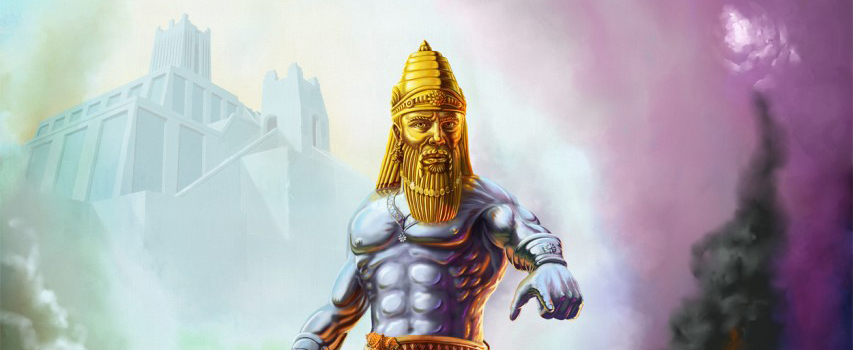By Ken Symes |
Daniel is a book of prophecy that in the Jewish order of the Bible, the Tenach, is grouped with the history books and not the prophetic books. If we are to understand it, as well as its significance today, two questions must be asked and answered. The first question is:
WHAT IS PROPHECY?
Peter, in his second epistle, gave us the answer when he wrote: “We have also a more sure word of prophecy; whereunto ye do well that ye take heed, as unto a light that shineth in a dark place, until day dawn, and the day star arise in your hearts: Knowing this first, that no prophecy of scripture is of any private interpretation. For the prophecy came not in old time by the will of man: but holy men of God spake as they were moved by the Holy Ghost.” 1
Peter informed us that prophecy came from God to holy men who were moved by the Spirit to write it down. So, to a large degree, prophecy is pre-written history. He thus makes it clear that, because it is God given, it is not open to private interpretation. It is to be understood in its literal sense as God said what He means.
The second question we need to answer is:
WHY SHOULD WE STUDY PROPHECY?
First, it appeals to our intellect as it is to be fulfilled literally. It is a “sure word.” This demands that, as we study it, our goal is to determine God’s message, not figure out what is our opinion. It also appeals to our emotions. Prophecy assures us that God is in control, that there is a hell to be shunned and a heaven to be gained. Prophecy not only appeals to our intellect and to our emotions; it also appeals to our will. Re-read 2 Peter 1:19. Peter tells us that prophecy becomes the motivation of our heart. If all prophecies to date have been literally fulfilled (and they have), we can be assured that God will fulfill literally all future prophecies. That should affect our will enabling us to trust Him and thus we should be led to serve Him.
At the time that Daniel wrote, Israel was in its darkest hour! The time was the summer of 605 B.C. The nation had been destroyed as had the Holy City and the Temple. All but a few had been carried off in captivity to Babylon. Israel, and Daniel, needed comfort! The book of Daniel is God’s comforting message to Daniel and to the Jewish people of that day. God’s message was clear: “It’s OK, Daniel. I have everything under control. I’m still in charge. It’s OK!” With this in mind, let us consider the setting of the vision of Nebuchadnezzar, king of Babylon.
THE SETTING OF THE VISION
Daniel’s life was about to be forever changed by a dream, but not his dream. The time occurred about 602 B.C. Nebuchadnezzar had a very disturbing dream which he promptly forgot. In the morning, he called all of his magicians and astrologers together and, under the pain of death, he demanded that his wise men not only interpret the dream, but tell him the dream. This group of wise men were made up of four different groups. There were the magicians, who in this case, were Babylonian priests or sages who also used magic. There was also a group of astrologers, who studied the stars and used enchantments, conjured up the dead, and communicated with spirits. The third group were the sorcerers who employed songs of magic, muttering magical words and all other forms of witchcraft. The fourth group was called Chaldeans, who delved in astrology. These wise men, with the Chaldeans speaking for the group2, objected that the king’s request was impossible. This led to the king becoming very angry, who forthwith commanded that all the wise men be put to death including Daniel.3 It is interesting to note that beginning with the response of the Chaldeans, in response to the king’s demands, this begins the Aramaic section of Daniel that continues through chapter seven. The rest of the book is written in Hebrew. Most conclude that this Aramaic section deals with prophecy of primary interest to the Gentiles and the Jews living in Babylon during the time of Daniel.
As Daniel was included in the group of wise men4, though he apparently was not present before the king earlier, as indicated by his response to the captain of the guard who came for Daniel to put him to death. He told Daniel what had just happened and about the king’s decree. Daniel went in to the king and requested to be given time stating that, if time was given him, he would show the king the interpretation. The king gave Daniel his request.5 Then Daniel went immediately to hold a prayer meeting with his Jewish friends, who were also included with the wise men, asking God to reveal the secret to Daniel so that they would not be put to death with the rest of the wise men. God answered their prayers and revealed to Daniel both the king’s dream and its interpretation.6 In verses 20-23, Daniel expresses his gratitude to God. Then he went to Arioch, the captain of the guard and asked him not to destroy the wise men but to take him to the king as he knew both the dream and the interpretation, which Arioch immediately did. It is important to note that Daniel, in making his presentation to the king, gave the God of Israel all the glory.7
THE KING’S VISION AND ITS INTERPRETATION
What Nebuchadnezzar saw in his dream was a great image of a man and a stone.8 The image was human in form and was so large and brilliant to the eye that it was terrifying: with a head of gold, breast and arms of silver, belly and thighs of bronze, legs of iron, and the feet a mixture of iron and clay. Then the king saw a stone which had been cut out of a mountain without hands that struck the feet of the image with such force that the whole image was destroyed into dust like chaff.
Then we read: “And the stone that smote the image became a great mountain, and filled the whole earth.” 9
After telling the king the dream Daniel went on to give the interpretation. In verses 37-38 Daniel tells the king that he is the head of gold. He goes on to explain to the king that his kingdom was given him by the true God, the God of Israel. The king represents the kingdom. Thus, the head of gold represents the kingdom of Babylon.
Daniel goes on to explain that four other kingdoms would follow and that God would ultimately establish His own kingdom, which would destroy all of the others.
The kingdom to follow after Babylon, represented by the breast and arms of silver, is Medo-Persia as history has so confirmed. The two arms coming together to form one breast pictures two peoples united as one. This occurred in 550 B.C. when the two peoples united, Media and Persia, who went on to conquer Babylon in 539 B.C.
The belly and two thighs of bronze represent Greece. Greece, under Alexander, conquered the Medo-Persian Empire in 331 B.C. fulfilling this part of the dream/vision.
The legs of iron, including the feet and toes of iron and clay, represent the Roman Empire. This is an accurate portrayal of the Roman Empire as it had two parts, Eastern/Western, which were ultimately divided in 364 A.D. into Rome and Constantinople. This part of the dream/vision was fulfilled when Rome conquered the kingdom of Greece in 146 B.C.
It is important to note that this empire would experience two distinct stages: an earlier stage which is already fulfilled and a later stage which is yet to be fulfilled. It is also important for us to see that this is the only kingdom not destroyed and replaced, allowing for its ultimate fulfillment in a second stage.
This final stage of the Roman Empire will be militarily strong but politically weak characterized by its division into ten toes. Apparently this will be a confederation of nations that join together for economic and military strength but continue to maintain their own identity. As this stage will depict much of the original Roman Empire, it will incorporate much of Europe and possibly some of western Asia. Its foundational form may be seen today in the organization of the European Common Market. In terms of prophetic history, we are living here.
It is this final kingdom that is prophesied to be smitten with the stone cut out of the mountain without hands. This clearly indicates that the coming of God’s kingdom will bring a complete end to Gentile rule in the destruction of the final stage of the Roman Empire.
As each succeeding kingdom absorbed the preceding kingdom, so Rome was a representative of all the kingdoms that went before it. But Rome, in its final stage, will be divinely destroyed and with it, the power of all Gentile rule will also be destroyed. Once every remnant of the image is removed, the stone becomes a great mountain that will fill the earth. This will be fulfilled with the establishment of the promised millennial kingdom promised in God’s Word, the final kingdom of this world, as we know it.
CONCLUSIONS
Nebuchadnezzar’s dream and interpretation revealed and explained to Daniel is a picture of Gentile rule on this earth. His image was of a man who was large, brilliant and terrifying to the eye.
Nebuchadnezzar saw an imposing outward power and the splendor of ‘the times of the Gentiles’. This prophecy clarifies that the “Time of the Gentiles” is not concluded until the Messiah returns to establish the millennial kingdom.
This prophecy also teaches us that God uses men and women who are willing to stand up and be counted on His side. Daniel lived in very bad times, but still took a stand for God without fear even before the king. Today, we are to take comfort in the knowledge that even in the worst of times God is still in control.
We are to draw strength from the fact of God’s sovereign control over the affairs of men. Daniel shows us that God purposes, promises and performs. He is in control! For those who know Him there is a day coming when we will be snatched out of this world but brought back later to be a part of His kingdom.10
If you do not know Him as your Messiah/Redeemer, receive Him today. Need help? Call or e-mail us. We are ready to help.
ENDNOTES
1. 2 Peter 1:19-21
2. Daniel 2:4, 10
3. Daniel 2:13
4. Daniel 1:19-20
5. Daniel 2:14-16
6. Daniel 2:17-19
7. Daniel 2:26-28
8. Daniel 2:31-35
9. Daniel 2:35b
10. 1Thessalonians 4:16-17;
Revelation 2:26-29

